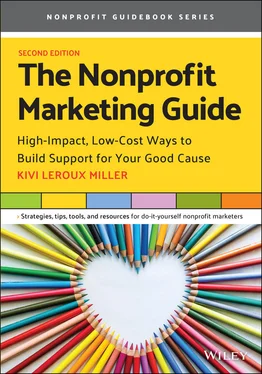But what does community engagement mean? Just as with the conversation about the difference between marketing and communications , it's essential that you define what community engagement means in the specific context of your work, because it can mean many different things.
At Nonprofit Marketing Guide, we define c ommunity engagement simply as keeping people inspired by and active in the work. To elaborate, community engagement includes awareness, interaction , and participation . Let's look at these elements a bit closer.
Awareness is about introducing your organization and/or your issues to people for the first time. Communications activities like search engine optimization, media relations, and list building are common awareness activities.
Interaction is about getting people to demonstrate that they are willing to move beyond just being aware of you and your cause. Activities such as liking, commenting, and sharing on social media are forms of interaction. Opening emails and clicking on links, downloading documents, and other simple form completions on your website would also fall under interaction.
Participation is a form of engagement that requires following through on a call to action of some sort. It could result in learning more, advocating for your cause, attending an event, donating, or volunteering.
As you think about what community engagement really means for your organization, give these three categories some thought. What is the right mix of awareness, interaction, and participation-building communications in your plan?
Now let's take a closer look at the specific goals, strategies, objectives, and tactics most commonly adopted by nonprofit communicators. Because the definitions of the various marketing strategies and objectives are new to many nonprofits, we'll spend the most time on those. We'll quickly summarize the goals and tactics, which are more widely understood.
If you get overwhelmed by all of the new vocabulary and definitions, don't worry. We'll go over a simplified plan next, in Chapter 3.
THE MOST COMMON NONPROFIT MARKETING GOALS
Marketing goals are the broad outcomes you seek via communications that help you achieve your larger organizational mission goals. In the nonprofit sector, a dozen goals represent the vast majority of the communications work. These 12 goals fall into four categories.
Community Engagement and Education Goals
Engaging our community to keep people inspired by and active in our work
Raising awareness of our issues to educate people on our cause
Advocating on our issues to change hearts and minds
Brand and Leadership Goals
Brand building and reputation management for the organization
Positioning our staff as thought leaders or experts
Communicating internally with our staff or board
Program Recruitment Goals
Recruiting and engaging participants to use our programs or services
Building our membership by recruiting and serving members of our organization
Recruiting and engaging volunteers to help deliver our programs and services
Fundraising Goals
Supporting fundraising from individuals making small to medium gifts
Supporting major donor fundraising
Supporting event fundraising (galas, walks, etc.)
It's common for communications staff to say they are expected to work on six or more of these goals simultaneously. Based on research from the 2019 Nonprofit Communications Trends Report , the most popular nonprofit communications goals are:
Engaging our communityBrand building and reputation managementRaising awareness of our issuesRecruiting and engaging program participantsSupporting event fundraisingSupporting fundraising from individuals making small to medium gifts
THE MOST COMMON NONPROFIT MARKETING STRATEGIES
The nonprofit sector employs a dozen different strategies, which are the marketing approaches used to achieve your goals. However, based on data first presented in the 2019 Nonprofit Communications Trends Report , we know the sector relies heavily on four marketing strategies in particular: permission-based marketing, content marketing, event and experience marketing, and relationship marketing.
Permission-based marketingis sharing content with specific people who have signed up, subscribed, or otherwise agreed in advance to join your mailing lists and lists of social followers. Nearly all nonprofits use this strategy in some way by building opt-in mailing lists.
Content marketingis attracting people to your work and retaining their interest in it by creating and distributing content they find especially valuable and relevant. It is also sometimes called inbound marketing.
Just because you are doing permission-based marketing doesn't mean you are doing content marketing! You can send advertising content or appeals to your opt-in email lists. That's permission-based marketing, but not necessarily content they find especially relevant and meaningful themselves. Sending advertising and appeals are more in your self-interest, even though you have permission to do so.
You can also use content marketing independent of your permission-based marketing mailing lists. For example, when you add great content to your website, people can find it with web searches and read it without being opted-in to any mailing list.
Of course, you find the sweet spot when these two strategies work together. You send great content that keeps people on your lists, which allows you to also send them advertising or appeals without them unsubscribing or unfollowing.
For much more detail on content marketing, please read my book, the award-winning Content Marketing for Nonprofits: A Communications Map for Engaging Your Community, Becoming a Favorite Cause, and Raising More Money (Jossey-Bass, 2013).
Event or experience marketingis using frequent events or participatory experiences to promote your programs and services, encouraging in-person interaction between your organization, supporters, or program participants.
Sometimes this strategy is confused with the “supporting event fundraising goal.” They are not the same thing.
If you are delivering programs and services via events and trying to get people to attend those events, then you are likely using permission-based marketing, content marketing, and general advertising strategies to market your events. Those events are programs or services and therefore your goals are more likely to raise awareness of your issues or to recruit and engage program participants.
If you are using events or experiences to market something other than donating, such as tours or happy hours to introduce new people to your organization, that's what I would consider an event and experience marketing strategy. The expectation is that the event or experience is merely the introductory first step in getting the attendees to do something else.
Relationship marketingis the fourth strategy most often employed by nonprofits. Relationship marketing is creating strong, long-term, loyal relationships with specific individuals and focusing on the quality of those relationships, rather than on individual transactions with those individuals. While the individuals will take a variety of actions in support of your nonprofit over the course of the relationship, their overall engagement with your cause is paramount. Major donor fundraising programs are often built on relationship marketing strategies.
Читать дальше












